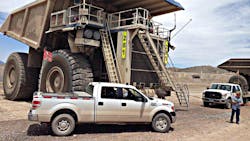The decision to move from steel to an all-aluminum bed and cab for the new generation Ford F-150 was widely seen as a big gamble given the F-150’s long success as the biggest selling pickup on the market. But it wasn’t a spur of the moment hunch bet; it was a decision based on a long history followed by massive R&D investments and finally validation through years – yes, years – of field testing.
With its real-world battering and abuse, it’s that final step that not only proves the concept, but also offers fleets a credible insight into the value of replacing tried and true steel body components with aluminum ones. Which is why in 2013 Ford sent two seemingly standard F-150s to the open-pit gold mines in the mountains of Nevada.
Barrick Gold USA of Elko, NV, has a large fleet of F-150s as well as heavier F-250s and F-350s supporting several mining operations throughout the state. Carrying crews on-road to its sites and then off-road around the pits that measure more than a mile wide, its pickups typically run 100,000 mi. over a three-year trade cycle. Accumulating half that mileage off-road, they’re worked hard carrying compressors, blasting suppliers and heavy tools, as well as towing trailers with pintle hitches.
The two F-150s sent to Barrick in late 2011 looked just like all the other then current models in the fleet and they came with no special instructions other than to work them like any other truck in the fleet. But Ford engineers had fitted them with aluminum cargo boxes ones that looked just like the standard steel ones.
“We wanted to get commercial fleet experience in the most abusive applications,” said Ford Truck project engineer Denis Kansier. In addition to the prototypes send to Barrick, Ford sent two into field service with an energy company in North Carolina and two to a dam construction project in Pennsylvania.
Barrick was the toughest test because on a daily basis it combined a 35-mi. run on paved highways to two mine sites, followed by similar mileage on unpaved roads within the sites and then a return highway trip to Elko, according to Kansier.
“We went out every three months to look at them and to solicit comments from the drivers,” he told Fleet Owner. “They didn’t notice anything different about the beds except that their magnetic work lights wouldn’t stick to them.” He added that the drivers only other comment was that they didn’t develop any rust around dents and paint chips.
As a result of the field tests, Ford found it needed to make only two design changes. “We up-gauged the aluminum in the floor to handle the pintle hitch and make it more dent resistant, and we changed an access cover on the tailgate to prevent damage when they dragged chains out of bed,” Kansier said.
What Barrick’s workers couldn’t see was that the aluminum bed was 60% thicker than the steel one it replaced but 40% lighter, resulting in a 700-lb. weight saving, according to the Ford Truck engineer.
“This was my first experience with commercial customers – real work guys – and aluminum bodies,” Kansier said. “It was an eye-opener to meet the customer and I learned a lot about the different ways our trucks are used in that world.”
Apparently Barrick was also impressed by the switch to a lighter material. The company has already ordered 35 of the new all-aluminum body F-150s – SuperCab 4x4 models with 3.5-liter V6s and 5.0-liter V-8s. Now they just need to find another way to mount their work lights.
About the Author
Jim Mele
Jim Mele is a former longtime editor-in-chief of FleetOwner. He joined the magazine in 1986 and served as chief editor from 1999 to 2017.
